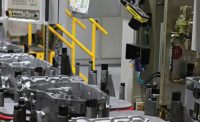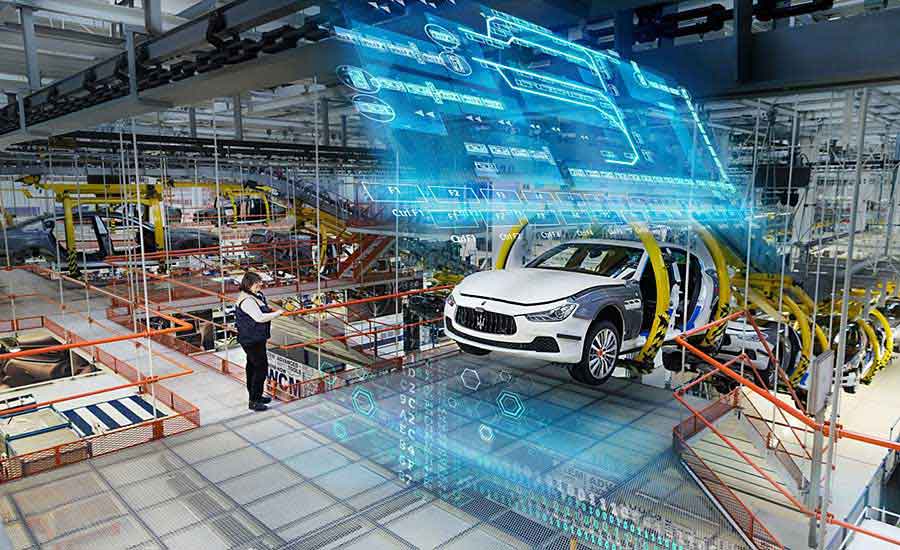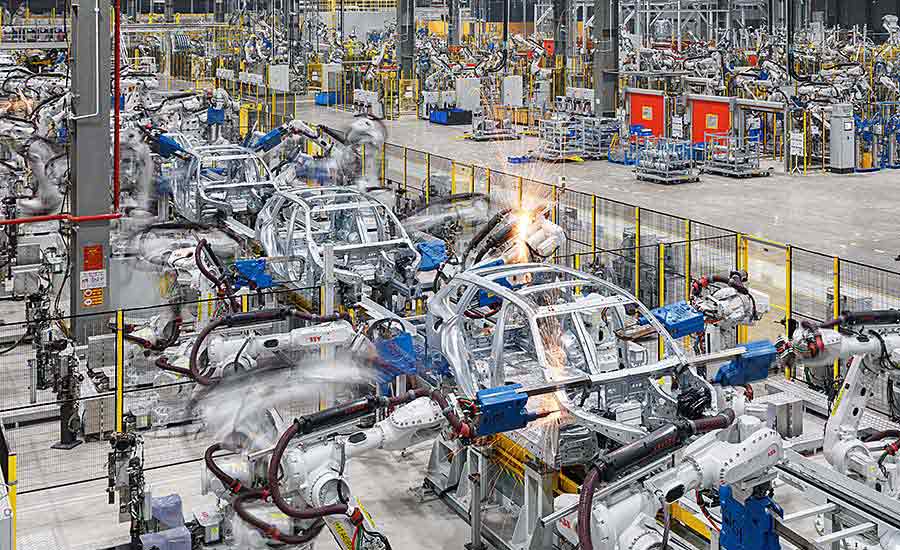Digital Technology Transforms Auto Assembly Lines

Automakers around the world are transforming their factories with digital technology. Illustration courtesy Siemens AG

Engineers are using digital twins to simulate and validate production processes. Illustration courtesy Siemens AG

Digital twins combine virtual products and production processes with the real world. Illustration courtesy Siemens AG

Digitalization is improving flexibility and productivity in automotive factories. Illustration courtesy Siemens AG

Nissan engineers used digital twin technology to build assembly lines for the new Ariya crossover vehicle. Photo courtesy Nissan Motor Co.

Digital tools enabled a start-up EV company in Vietnam to quickly ramp up production. Photo courtesy VinFast LLC






Automakers around the world are transforming their factories with digital technology. The goal is to improve productivity and increase the efficiency of both people and equipment.
Engineers are using digital twins to simulate production processes and assembly line layouts before allocating time and resources in the physical space.
Digital twins are virtual representations of machines, products or processes. Fed with real-time data, they can predict and optimize things such as equipment performance, reliability, quality and energy efficiency.
“The term ‘digital twin’ appears in many vendors’ marketing programs, with a wide variety of interpretations,” says Ralph Rio, vice president of enterprise software at ARC Advisory Group. “A digital twin is a dynamic virtual representation of a physical entity using real-world data synchronized from multiple sources. The representation can take a form ranging from a mathematical algorithm to a 4D model.”
One of the companies at the leading edge of deploying digital twin technology in the auto industry is Siemens AG.
"The industrial world is facing rapidly changing challenges," says Bernd Mangler, senior vice president and head of automotive vertical at Siemens. "Faster time to market, becoming more efficient, flexible and sustainable, and increased quality are just some of them.
"To address these challenges and remain competitive, [manufacturers] need to successfully master their digital transformation," notes Mangler. "It is essential to collect, understand and use the massive amount of data created in the Industrial Internet of Things (IIoT). For that, it is necessary to become a digital enterprise by combining the real and the digital worlds."
Improved Flexibility and Productivity
Digitalization is improving flexibility and productivity in the fast-changing world of automobile manufacturing.
"The automotive industry is the technological trendsetter (innovation pioneer) among manufacturing industries," says Mangler. "It keeps evolving on a fast pace and is a driver of the new era of digitalization. Digitalization helps the automotive industry turn their ideas into successful vehicles faster and more efficiently.
"Combining the real and the digital worlds makes it possible to seamlessly integrate the entire value chain from design to realization, while optimizing with a continuous flow of data," explains Mangler.
"The digital enterprise brings together processes that were previously separate," Mangler points out. "It breaks down traditional silos and helps bridge the gaps between software and hardware, IT and OT, shop floor and top floor. This offers great optimization potential, including precise condition monitoring and improved quality.
"For automakers to adopt efficiently to new technologies evolving in the industry, such as battery cell, module and pack assembly, standardization plays a key role as base for digitalization," claims Mangler. "With standardization, automakers can increase the transparency and scalability of its production. And, it brings the greater potential for improvement by applying and scaling digitalization to go to the next level of automotive production."
According to Mangler, digital twin technology enables automakers to decrease downtime, strengthen cybersecurity, make better real-time decisions, and introduce intelligent automation to improve productivity, flexibility and sustainability.
A digitalized automotive assembly line is different than a traditional non-digital assembly line. Introducing more functionality, while significantly reducing the current cycle time, tracking quality and becoming more productive, are just a few ways how manufacturers can benefit from digitalization.
Digital technology can also help automakers and suppliers transition to electric vehicle production. From car design and production planning to actual production, an integrated database makes it possible to continuously analyze and optimize all workflows and processes. Planning and simulation software can help shorten ramp-up time and streamline operations.
Electric vehicles require a significant increase in electronics content, a more complex electrical architecture, multiple voltage systems and advanced software. As a result, engineers need to consider more variables than ever. Digital twin technology can enable legacy and start-up EV manufacturers to improve efficiency, move faster and scale up, while keeping costs low.
"The transition from internal combustion to electric vehicles is a gradual process," explains Mangler. "[[Automakers] need flexible and innovative assembly concepts that allow the manufacture of electric vehicles to occur alongside and integrate with existing production lines."
By implementing comprehensive digital twin technology, automakers can improve collaboration across electrical, mechanical, software and design engineering teams, in addition to supply chain partners, says Mangler. It creates ways to share requirements, design and manufacturing data across engineering disciplines, making it easier to track all changes and ensure traceability automatically.
"The automotive industry is reshaping faster than ever before," adds Mangler. "Technology advancements are redefining transportation from traditional mechanics to complex sustainable, entertaining, and connected mobility enabled by electronics and software. Virtual commissioning as well as simulation in other phases of the life cycle can be increasingly found in the requirement specifications of the automotive industry to validate processes at an early stage.
"The digital approach minimizes risks and can reduce actual commissioning time drastically," says Mangler. "This saves a lot of testing work and late program changes under pressure, resulting in a faster start of production. Automakers can decrease downtime, strengthen cybersecurity, make better real-time decisions, and introduce intelligent automation to improve productivity, flexibility and sustainability.
"Digitalization offers tremendous opportunities for assembly automation," claims Mangler. "Introducing more functionality while significantly reducing the current cycle time, tracking quality and becoming more productive are just a few ways how manufacturers can benefit from digitalization. But, optimized production requires extensive data analysis of machines, production lines and entire factories."
Digital Twins in Action
Automakers around the world are using digital twins to develop and produce EVs, including legacy firms such as Nissan Motor Co. and start-ups such as VinFast LLC.
Siemens recently partnered with Nissan to build production lines for the new Ariya crossover at the company’s assembly plant in Tochigi, Japan. Nissan had already been using the Siemens Digital Industries software portfolio to optimize design and production. Its end-to-end digital threads enable engineers to connect a wide variety of sources of information across product lifecycle management platforms.
“The successful launch of the new production lines is a milestone in the collaboration of the two companies,” says Cedrik Neike, CEO of Siemens Digital Industries. “Climate change and stringent environmental regulations are powerful drivers for the development of electrified power trains. Our cutting-edge technologies…enable highly flexible, efficient and sustainable automotive production.”
“At our Nissan Intelligent Factory in Tochigi, we are building the future of mobility,” adds Teiji Hirata, vice president of vehicle production engineering and development at Nissan. “It enables us to not only improve the work environment, but also to realize a zero-emission production system.”
The system architecture of Nissan’s newly developed electric power train aims to standardize assembly processes. It includes Siemens’ safety PLC Simatic S7-1500 and ET200SP distributed I/O module. Profinet creates end-to-end communication from the field to the management level, and the engineering framework TIA Portal has also fully integrated all automation devices.
This enables complete access to the entire digitalized automation process, from digital planning to integrated engineering and transparent operation. The Siemens diagnostic commissioning system, Sidis Pro, which has already been deployed in many automobile companies around the world, is implemented at Nissan’s new production line for data writing into ECU and verifying automotive electric components.
Sidis Pro manages a wide range of data with server functions, contributing to the digitization of production lines. It enables maximum flexibility in automotive production, because it is easily modifiable and changes can be adapted quickly. The same software can be used for different applications, enabling system standardization.
Siemens also recently helped VinFast build the first fully digital automotive assembly plant in Southeast Asia. The electric car factory in Hai Phong, Vietnam, was built in just 21 months, which is 50 percent faster than most greenfield facilities.
Engineers used Siemens’ Tecnomatix software to implement lean manufacturing and automation initiatives. A closed-loop manufacturing system uses digital twins of products and production processes.
This holistic approach has increased speed and flexibility in development, ensured high global standards in production, optimized the manufacturing process, and made the entire plant ready for further expansions and new business models.
Digital twin technology used by VinFast engineers creates new insights, thanks to the combination of physics-based simulations with data analytics in a fully virtual environment. This makes it possible to realize innovations faster and more reliably, while also requiring significantly fewer real prototypes.
Production performance data is collected, analyzed and fed back into the development cycle to help engineers improve and optimize new products and processes at an early stage.
Looking for a reprint of this article?
From high-res PDFs to custom plaques, order your copy today!











